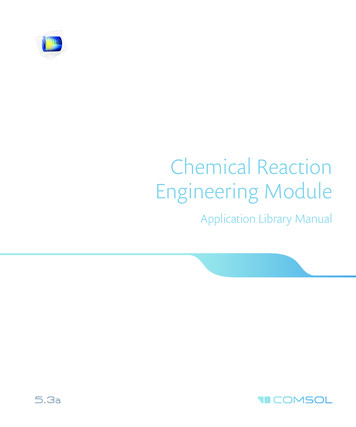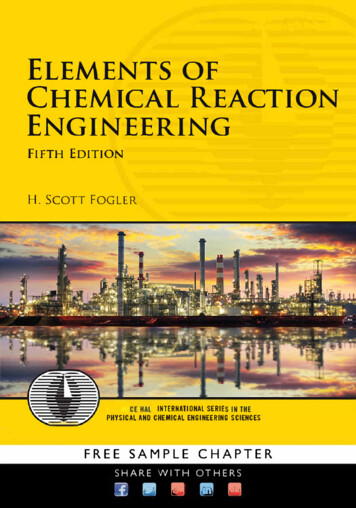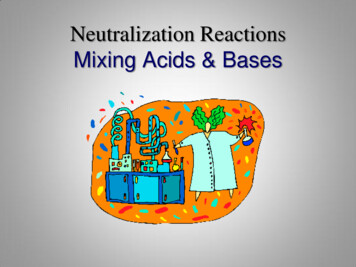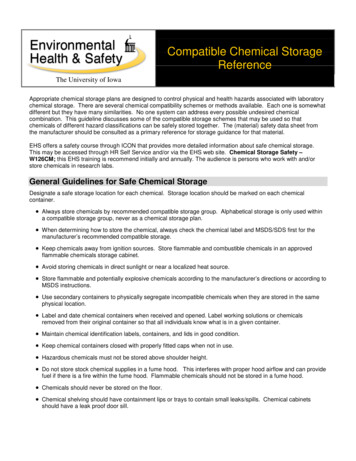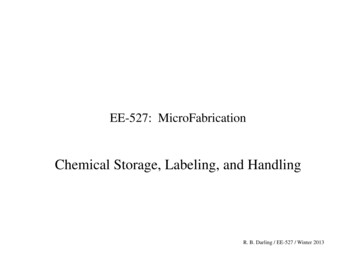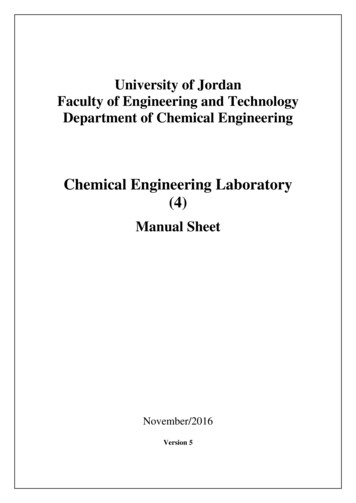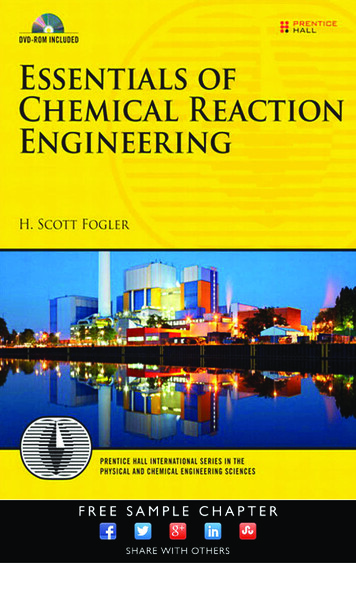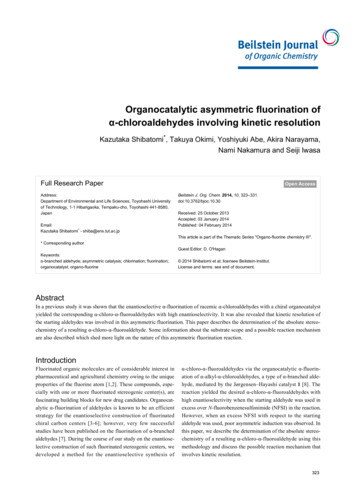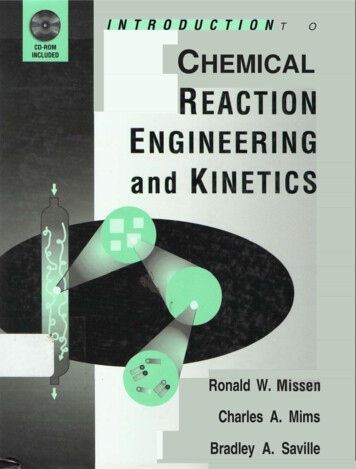
Transcription
INTRODUCTION TOCHEMICALREACTIONRonald W. MissenCharles A. MimsBradley A. Saville
INTRODUCTION TOCHEMICAL REACTIONENGINEERING ANDKINETICS
INTRODUCTION TOCHEMICAL REACTIONENGINEERING ANDKINETICSRonald W. MissenCharles A. MimsBradley A. SavilleDepartment of Chemical Engineering and Applied ChemistryUniversity of TorontoJohn Wiley & Sons, Inc.New York l ChichesterlWeinheimlBrisbanelSingaporelToronto
No. ADQUIS!CII?N02”2’:-34C SIFICAGCN***“**--.- . . . . . . . . . . . . . . . . . . . .yCT”AA . . .&-;; g@. . . . . . . . . . . . . . . .-.”-*. . . . . . . . . . 2.335,,,FEWA . . . . . . . . . . . . . . .I.zA,. EJ. *-- **. . . . . . . . . . . . . . “v ‘(I. . . . . . . . . . . . . . . “. ’ --- . . . . . - . . . . . . . . . . . . . . I-Acquisitions EditorMarketing ManagerFreelance Production ManagerDesignerIllustration EditorOutside Production ManagementCover DesignWayne AndersonKatherine HepburnJeanine FurinoLaura BoucherGene AielloHermitage Publishing ServicesKeithley AssociatesThis book was set in Times Ten by Publication Services and printed and bound by Hamilton Printing.The cover was printed by Lehigh Press.This book is printed on acid-free paper. @The paper in this book was manufactured by a mill whose forest management programs include sustainedyield harvesting of its timberlands. Sustained yield harvesting principles ensure that the number of treescut each year does not exceed the amount of new growth.Copyright 1999 0 John Wiley & Sons, Inc. All rights reserved.No part of this publication may be reproduced, stored in a retrieval system or transmittedin any form or by any means, electronic, mechanical, photocopying, recording, scanningor otherwise, except as permitted under Sections 107 and 108 of the 1976 United StatesCopyright Act, without either the prior written permission of the Publisher, orauthorization through payment of the appropriate per-copy fee to the CopyrightClearance Center, 222 Rosewood Drive, Danvers, MA 01923, (508) 7508400, fax(508) 750-4470. Requests to the Publisher for permission should be addressed to thePermissions Department, John Wiley & Sons, Inc., 605 Third Avenue, New York, NY101580012, (212) 850-6011, fax (212) 850-6008, E-Mail: PERMREQ@WILEY.COM.Library of Congress Cataloging-in-Publication Data:Missen, Ronald W. (Ronald William), 192%Introduction to chemical reaction engineering and kinetics /Ronald W. Missen, Charles A. Mims, Bradley A. Saville.p. cm.Includes bibliographical references and index.ISBN 0-471-16339-2 (cloth : alk. paper)1. Chemical reactors. 2. Chemical kinetics. I. Mims, Charles A.II. Saville, Bradley A. III. Title.TP157.M538 1999660’.2832-dc2198-27267CIPPrinted in the United States of America1098765432
Introduction to Chemical Reaction Engineering and Kinetics is written primarily fora first course in chemical reaction engineering (CRE) for undergraduate students inchemical engineering. The purpose of the work is to provide students with a thoroughintroduction to the fundamental aspects of chemical reactor analysis and design. Forthis purpose, it is necessary to develop a knowledge of chemical kinetics, and thereforethe work has been divided into two inter-related parts: chemical kinetics and CRE. Included with this book is a CD-ROM containing computer software that can be used fornumerical solutions to many of the examples and problems within the book. The workis primarily based on material given to undergraduate students in the Department ofChemical Engineering and Applied Chemistry at the University of Toronto.Scope and Organization of MaterialThe material in this book deals with kinetics and reactors. We realize that studentsin many institutions have an introduction to chemical kinetics in a course on physical chemistry. However, we strongly believe that for chemical engineering students, kinetics should be fully developed within the context of, and from the point of view of,CRE. Thus, the development given here differs in several important respects from thatgiven in physical chemistry. Ideal-flow reactor models are introduced early in the book(Chapter 2) because of their use in kinetics investigations, and to get students accustomed to the concepts early. Furthermore, there is the additional purpose of drawinga distinction between a reaction model (network) or kinetics scheme, on the one hand,and a reactor model that incorporates a kinetics scheme, on the other. By a reactionmodel, we mean the development in chemical engineering kinetics of an appropriate(local or point) rate law, including, in the case of a multiphase system, the effects ofrate processes other than chemical reaction itself. By contrast, a reactor model uses therate law, together with considerations of residence-time and (if necessary) particle-sizedistributions, heat, mass, and momentum transfer, and fluid mixing and flow patterns,to establish the global behavior of a reacting system in a vessel.We deliberately separate the treatment of characterization of ideal flow (Chapter 13)and of nonideal flow (Chapter 19) from the treatment of reactors involving such flow.This is because (1) the characterization can be applied to situations other than those involving chemical reactors; and (2) it is useful to have the characterization complete inthe two locations so that it can be drawn on for whatever reactor application ensues inChapters 14-18 and 20-24. We also incorporate nonisothermal behavior in the discussion of each reactor type as it is introduced, rather than treat this behavior separatelyfor various reactor types.Our treatment of chemical kinetics in Chapters 2-10 is such that no previous knowledge on the part of the student is assumed. Following the introduction of simple reactor models, mass-balance equations and interpretation of rate of reaction in Chapter 2,and measurement of rate in Chapter 3, we consider the development of rate laws forsingle-phase simple systems in Chapter 4, and for complex systems in Chapter 5. This isvii
viii Prefacefollowed by a discussion of theories of reaction and reaction mechanisms in Chapters 6and 7. Chapter 8 is devoted to catalysis of various types. Chapter 9 is devoted to reactions in multiphase systems. The treatment of chemical kinetics concludes in Chapter 10with a discussion of enzyme kinetics in biochemical reactions.Our treatment of Chemical Reaction Engineering begins in Chapters 1 and 2 andcontinues in Chapters 11-24. After an introduction (Chapter 11) surveying the field,the next five Chapters (12-16) are devoted to performance and design characteristics of four ideal reactor models (batch, CSTR, plug-flow, and laminar-flow), and tothe characteristics of various types of ideal flow involved in continuous-flow reactors.Chapter 17 deals with comparisons and combinations of ideal reactors. Chapter 18deals with ideal reactors for complex (multireaction) systems. Chapters 19 and 20treat nonideal flow and reactor considerations taking this into account. Chapters 2124 provide an introduction to reactors for multiphase systems, including fixed-bedcatalytic reactors, fluidized-bed reactors, and reactors for gas-solid and gas-liquidreactions.Ways to Use This Book in CRJ3 CoursesOne way in which the material can be used is illustrated by the practice at the University of Toronto. Chapters 1-8 (sections 8.1-8.4) on chemical kinetics are used fora 40-lecture (3 per week) course in the fall term of the third year of a four-year program; the lectures are accompanied by weekly 2-hour tutorial (problem-solving) sessions. Chapters on CRE (ll-15,17,18, and 21) together with particle-transport kineticsfrom section 8.5 are used for a similarly organized course in the spring term. There ismore material than can be adequately treated in the two terms. In particular, it is notthe practice to deal with all the aspects of nonideal flow and multiphase systems that aredescribed. This approach allows both flexibility in choice of topics from year to year,and material for an elective fourth-year course (in support of our plant design course),drawn primarily from Chapters 9,19,20, and 22-24.At another institution, the use of this material depends on the time available, the requirements of the students, and the interests of the instructor. The possibilities include:(1) a basic one-semester course in CRE primarily for simple, homogeneous systems,using Chapters 1-4 (for kinetics, if required) and Chapters 11-17;(2) an extension of (1) to include complex, homogeneous systems, using Chapters 5(for kinetics) and 18 in addition;(3) a further extension of (1) and (2) to include heterogeneous systems using Chapters 8 and 9 (for kinetics), and selected parts of Chapters 21-24;(4) a final extension to nonideal flow, using Chapters 19 and 20.In addition, Chapters 6 and 7 could be reserved for the enrichment of the treatmentof kinetics, and Chapter 10 can be used for an introduction to enzyme kinetics dealingwith some of the problems in the reactor design chapters.Reviewers have suggested that this book may be used both at the undergraduate leveland at the beginning of a graduate course. The latter is not our intention or our practice,but we leave this to the discretion and judgement of individual instructors.Problem Solving and Computer ToolsWe place primary emphasis on developing the students’ abilities to establish the working equations of an appropriate model for a particular reactor situation, and of courseto interpret and appreciate the significance of quantitative results. In an introductorytext in a field such as CRE, it is important to emphasize the development of principles,
Preface ixand to illustrate their application by means of relatively simple and idealized problem situations that can be solved with a calculator. However, with the availability ofcomputer-based solution techniques, it is desirable to go beyond this approach for several reasons:(1) Computer software allows the solution of more complex problems that requirenumerical, as opposed to analytical, techniques. Thus, a student can explore situations that more closely approximate real reactor designs and operating conditions. This includes studying the sensitivity of a calculated result to changingoperating conditions.(2) The limitations of analytical solutions may also interfere with the illustration ofimportant features of reactions and of reactors. The consequences of linear behavior, such as first-order kinetics, may be readily demonstrated in most cases byanalytical techniques, but those of nonlinear behavior, such as second-order orLangmuir-Hinshelwood kinetics, generally require numerical techniques.(3) The development of mechanistic rate laws also benefits from computer simulations. All relevant elementary steps can be included, whereas, with analyticaltechniques, such an exploration is usually impossible.(4) Computer-aided visual demonstrations in lectures and tutorials are desirable fortopics that involve spatial and/or time-dependent aspects.For these reasons, we include examples and problems that require numerical techniques for their solution together with suitable computer software (described below).v0“OPComputer Software: E-Z Solve: The Engineer’s Equation Solving andAnalysis ToolAccompanying this book is a CD-ROM containing the computer software E-Z Solve,developed by IntelliPro, Inc and distributed by John Wiley & Sons, Inc. It can be usedfor parameter estimation and equation solving, including solution of sets of both nonlinear algebraic equations and differential equations. It is extremely easy to learn anduse. We have found that a single 2-hour tutorial is sufficient to instruct students in itsapplication. We have also used it in research problems, such as modeling of transientbehavior in kinetics investigations. Other computer software programs may be used,if appropriate, to solve most of the examples and problems in the text that are solvedwith the aid of E-Z Solve (indicated in the text by a computer icon shown in the margin above). The successful use of the text is not restricted to the use of E-Z Solve forsoftware support, although we encourage its use because of its capabilities for nonlinear parameter estimation and solution of coupled differential and algebraic equations.Appendix D provides examples illustrating the use of the software for these types ofproblems, along with the required syntax.Web SiteA web site at www.wiley.com/college/missenis available for ongoing support of thisbook. It includes resources to assist students and instructors with the subject matter,such as sample files, demonstrations, and a description of the E-Z Solve software appearing on the CD-ROM that accompanies this book.AcknowledgmentsWe acknowledge our indebtedness to those who have contributed to the literature onthe topics presented here, and on whose work we have drawn. We are grateful for the
x Prefacecontributions of S.T. Balke, W.H. Burgess, and M.J. Phillips, who have participated inthe undergraduate courses, and for discussions with W.R. Smith. We very much appreciate the comments on the manuscript received from reviewers. CAM credits, in additionto his academic colleagues, his former coworkers in industry for a deep and continuingeducation into the subject matter.We are also grateful for the assistance given by Esther Oostdyk, who entered themanuscript; by Lanny Partaatmadja, who entered material for the “Instructor Resources”; and by Mark Eichhorn, Nick Palozzi, Chris Ho, Winnie Chiu and LannyPartaatmadja, who worked on graphics and on problems for the various chapters. Wealso thank Nigel Waithe, who produced copies of draft material for the students. Wethank our students for their forbearance and comments, both written and oral, duringthe development of this book.The development of the computer tools and their integration with the subject matterrequired strong support from Wayne Anderson and the late Cliff Robichaud at Wiley,and Philippe Marchal and his staff at Intellipro. Their assistance is gratefully acknowledged. We also thank the staff at Wiley and Larry Meyer and his staff at HermitagePublishing Services for their fine work during the production phase.Support for the development of the manuscript has been provided by the Departmentof Chemical Engineering and Applied Chemistry, the Faculty of Applied Science andEngineering, and the Office of the Provost, University of Toronto.Ronald W. MissenCharles A. MimsBradley A. SavilleToronto, Ontario. May, 1998
Contents1 . INTRODUCTION 11.1 Nature and Scope of Chemical Kinetics11.2 Nature and Scope of Chemical Reaction Engineering1.3 Kinetics and Chemical Reaction Engineering 21.4 Aspects of Kinetics 31.4.11.4.21.4.31.4.41.4.51.4.6Rate of Reaction-Definition 3Parameters Affecting Rate of Reaction: The Rate LawMeasurement of Rate of Reaction-Preliminary 5Kinetics and Chemical Reaction Stoichiometry 6Kinetics and Thermodynamics/Equilibrium 14Kinetics and Transport Processes 151.5 Aspects of Chemical Reaction Engineering 151.5.11.5.21.5.31.5.4Reactor Design and Analysis of Performance15Parameters Affecting Reactor Performance 16Balance Equations 16An Example of an Industrial Reactor181.6 Dimensions and Units 191.7 Plan of Treatment in Following Chapters211.7.1 Organization of Topics 211.7.2 Use of Computer Software for Problem Solving211.8 Problems for Chapter 1 22,-. 2 . KINETICS AND IDEAL REACTOR MODELS2.1 Time Quantities 252.2 Batch Reactor (BR) 26252.2.1 General Features 262.2.2 Material Balance; Interpretation ri of 272.3 Continuous Stirred-Tank Reactor (CSTR) 292.3.1 General Features 292.3.2 Material Balance; Interpretation of ri 312.4 Plug-Flow Reactor (PFR) 332.4.1 General Features 332.4.2 Material Balance; Interpretation ri of 342.52.62.72.83lLaminar-FIow Reactor (LFR) 36Smnmary of Results for Ideal Reactor ModelsStoichiometric Table 39Problems for Chapter 2 40EXPERIMENTAL METHODS IN KINETICS:MEASUREMENT OF RATE OF REACTION3.1 Features of a Rate Law: Introduction4238423.1.1 Separation of Effects 423.1.2 Effect of Concentration: Order of Reaction423.1.3 Effect of Temperature: Arrhenius Equation; Activation Energy44xi
xii Contents3.2 Experimental Measurements: General Considerations453.3 Experimental Methods to Follow the Extent of Reaction463.3.1 Ex-situ and In-situ Measurement Techniques463.3.2 Chemical Methods463.3.3 Physical Methods473.3.4 Other Measured Quantities483.4 Experimental Strategies for Determining Rate Parameters483.4.1 Concentration-Related Parameters: Order of Reaction493.4.2 Experimental Aspects of Measurement of Arrhenius Parameters A and EA3.5 Notes on Methodology for Parameter Estimation573.6 Problems for Chapter 3614 . DEVELOPMENT OF THE RATE LAW FOR A SIMPLE SYSTEM4.1 The Rate Law644.1.1 Form of Rate Law Used644.1.2 Empirical versus Fundamental Rate Laws654.1.3 Separability versus Nonseparability of Effects664.2 Gas-Phase Reactions: Choice of Concentration Units664.2.1 Use of Partial Pressure664.2.2 Rate and Rate Constant in Terms of Partial Pressure674.2.3 Arrhenius Parameters in Terms of Partial Pressure684.3 Dependence of Rate on Concentration694.3.1 First-Order Reactions694.3.2 Second-Order Reactions714.3.3 Third-Order Reactions724.3.4 Other Orders of Reaction754.35 Comparison of Orders of Reaction754.3.6 Product Species in the Rate Law784.4 Dependence of Rate on Temperature794.4.1 Determination of Arrhenius Parameters794.4.2 Arrhenius Parameters and Choice of Concentration Units for Gas-PhaseReactions 804.5 Problems for Chapter 4805 . COMPLEXSYSTEMS87 -5.1 Types and Examples of Complex Systems8751.1 Reversible (Opposing) Reactions875.1.2 Reactions in Parallel885.1.3 Reactions in Series885.1.4 Combinations of Complexities885.1.5 Compartmental or Box Representation of Reaction Network895.2 Measures of Reaction Extent aud Selectivity905.2.1 Reaction Stoichiometry and Its Significance905.2.2 Fractional Conversion of a Reactant915.2.3 Yield of a Product915.2.4 Overall and Instantaneous Fractional Yield925.2.5 Extent of Reaction935.2.6 Stoichiometric Table for Complex System935.3 Reversible Reactions945.3.1 Net Rate and Forms of Rate Law945.3.2 Thermodynamic Restrictions on Rate and on Rate Laws955.3.3 Determination of Rate Constants975.3.4 Optimal T for Exothermic Reversible Reaction995.4 Parallel Reactions1001035.5 Series Reactions5764
Contentsxiii5.6 Complexities Combined10656.1 Concept of Rate-Determining Step (rds)10656.2 Determination of Reaction Network1065.7 Problems for Chapter 51086 . FUNDAMENTALS OF REACTION RATES1156.1 Prelhninary Considerations 1156.1.1 Relating to Reaction-Rate Theories 1156.1.2 Relating to Reaction Mechanisms and Elementary Reactions1166.2 Description of Elementary Chemical Reactions1176.2.1 Types of Elementary Reactions 1176.2.2 General Requirements for Elementary Chemical Reactions1206.3 Energy in Molecules 1201206.3.1 Potential Energy in Molecules-Requirements for Reaction6.3.2 Kinetic Energy in Molecules 1266.4 Simple Collision Theory of Reaction Rates1286.4.1 Simple Collision Theory (XT) of Bimolecular Gas-Phase Reactions1296.4.2 Collision Theory of Unimolecular Reactions1346.4.3 Collision Theory of Bimolecular Combination Reactions; TermolecularReactions 1376.5 TransitionState Theory (TST) 1396.5.1 General Features of the TST 1396.5.2 Thermodynamic Formulation 1416.5.3 Quantitative Estimates of Rate Constants Using TST with Statistical Mechanics1436.5.4 Comparison of TST with SCT 1456.6 Elementary Reactions Involving Other Than Gas-Phase Neutral Species1466.6.1 Reactions in Condensed Phases 1466.6.2 Surface Phenomena 1476.6.3 Photochemical Elementary Reactions 1496.6.4 Reactions in Plasmas 1506.7 Summary 1516.8 Problems for Chapter 6 1527 . HOMOGENEOUS REACTION MECHANISMS AND RATE LAWS7.1 Simple Homogeneous Reactions 1557.1.1 Types of Mechanisms 1557.1.2 Open-Sequence Mechanisms: Derivation of Rate Law from Mechanism7.1.3 Closed-Sequence Mechanisms; Chain Reactions 1577.1.4 Photochemical Reactions 1637.2 Complex Reactions 1647.2.1 Derivation of Rate Laws 1647.2.2 Computer Modeling of Complex Reaction Kinetics1657.3 Polymerization Reactions 1657.3.1 Chain-Reaction Polymerization 1667.3.2 Step-Change Polymerization 1687.4 Problems for Chapter 7 1708 . CATALYSIS AND CATALYTIC REACTIONS 1768.1 Catalysis and Catalysts 17681.1 Nature and Concept 17681.2 Types of Catalysis 17881.3 General Aspects of Catalysis 179 8.2 Molecular Catalysis 1828.2.1 Gas-Phase Reactions 1828.2.2 Acid-Base Catalysis 183155154
xiv Contents8.2.3 Other Liquid-Phase Reactions1868.2.4 Organometallic Catalysis1868.3 Autocatalysis1878.4 Surface Catalysis: Intrinsic Kinetics1918.4.1 Surface-Reaction Steps1918.4.2 Adsorption Without Reaction: Langmuir Adsorption Isotherm8.4.3 Langmuir-Hinshelwood (LH) Kinetics1958.4.4 Beyond Langmuir-Hinshelwood Kinetics1978.5 Heterogeneous Catalysis: Kinetics in Porous Catalyst Particles8.5.1 General Considerations1988.5.2 Particle Density and Voidage (Porosity)1998.5.3 Modes of Diffusion; Effective Diffusivity1998.5.4 Particle Effectiveness Factor 772018.5.5 Dependence of n on Temperature2108.5.6 Overall Effectiveness Factor Q2128.6 Catalyst Deactivation and Regeneration2148.6.1 Fouling2148.6.2 Poisoning2158.6.3 Sintering2158.6.4 How Deactivation Affects Performance2168.6.5 Methods for Catalyst Regeneration2168.7 Problems for Chapter 8218192198REACTING SYSTEMS2249.1 Gas-Solid (Reactant) Systems 2249.1.1 Examples of Systems 2249.1.2 Constant-Size Particle 2259.1.3 Shrinking Particle 2379.2 Gas-Liquid Systems 2399.2.1 Examples of Systems 2399.2.2 Two-Film Mass-Transfer Model for Gas-Liquid Systems2409.2.3 Kinetics Regimes for Two-Film Model2429.3 Intrinsic Kinetics of Heterogeneous Reactions Involving Solids9.4 Problems for Chapter 9 2579 0’ MULTIPHASE10 . BIOCHEMICALREACTIONS:ENZYME KINETICS10.1 Enzyme Catalysis 26110.1.1 Nature and Examples of Enzyme Catalysis26110.1.2 Experimental Aspects 26310.2 Models of Enzyme Kinetics 26410.2.1 Michaelis-MentenModel 26410.2.2 Briggs-Haldane Model 26610.3 Estimation of K,,, and V,, 26710.3.1 Linearized Form of the Michaelis-MentenEquation26710.3.2 Linearized Form of the Integrated Michaelis-MentenEquation10.3.3 Nonlinear Treatment 26910.4 Inhibition and Activation in Enzyme Reactions26910.4.1 Substrate Effects 27010.4.2 External Inhibitors and Activators 27210.5 Problems for Chapter 10 27625526126911 . PRELIMINARY CONSIDERATIONS IN CHEMICAL REACTIONENGINEERING 27911.1 Process Design and Mechanical Design11.1.1 Process Design 27911.1.2 Mechanical Design 283279
Contents xv11.2 Examples of Reactors for Illustration of Process Design Considerations11.2.1 Batch Reactors 28311.2.2 Stirred-Tank Flow Reactors 28411.2.3 Tubular Flow Reactors 28411.2.4 Fluidized-Bed Reactors 29011.2.5 Other Types of Reactors 29111.3 Problems for Chapter 11 29212lBATCH REACTORS (BR) 29412.1 Uses of Batch Reactors 29412.2 Batch Versus Continuous Operation 29512.3 Design Equations for a Batch Reactor29612.3.1 General Considerations 29612.3.2 Isothermal Operation 30012.3.3 Nonisothermal Operation 30412.3.4 Optimal Performance for Maximum Production Rate30712.4 Semibatch and Semicontinuous Reactors 30912.4.1 Modes of Operation: Semibatch and Semicontinuous Reactors12.4.2 Advantages and Disadvantages (Semibatch Reactor) 31012.4.3 Design Aspects 31112.5 Problems for Chapter 12 31330913 . IDEALFLOW 31713.1 Terminology 31713.2 Types of Ideal Flow; Closed and Open Vessels31813.2.1 Backmix Flow (BMF) 31813.2.2 Plug Flow (PF) 31813.2.3 Laminar Flow (LF) 31813.2.4 Closed and Open Vessels 31813.3 Characterization of Fiow By Age-Distribution Functions31913.3.1 Exit-Age Distribution Function E 31913.3.2 Cumulative Residence-Time Distribution Function F 32113.3.3 Washout Residence-Time Distribution Function W 32213.3.4 Internal-Age Distribution Function I 32213.3.5 HoldbackH 32232213.3.6 Summary of Relationships Among Age-Distribution Functions13.3.7 Moments of Distribution Functions 32313.4 Age-Distribution Functions for Ideai Fiow 32513.4.1 Backmix Flow (BMF) 32513.4.2 Plug Flow (PF) 32713.4.3 Laminar Flow (LF) 33013.4.4 Summary of Results for Ideal Flow33213.5 Segregated Fiow 33213.6 Problems for Chapter 13 33314 . CONTINUOUS STIRRED-TANK REACTORS (CSTR)14.1 Uses of a CSTR 33614.2 Advantages and Disadvantages of a CSTR33614.3 Design Equations for a Single-Stage CSTR33614.3.1 General Considerations; Material and Energy Balances14.3.2 Constant-Density System 33914.3.3 Variable-Density System 34414.3.4 Existence of Multiple Stationary States 34714.4 Multistage CSTR 35514.4.1 Constant-Density System; Isothermal Operation 35114.4.2 Optimal Operation 35814.5 Problems for Chapter 14 361336335283
xvi Contents15 . PLUG FLOW REACTORS (PFR)36515.1 Uses of a PFR 36515.2 Design Equations for a PFR 36615.2.1 General Considerations; Material, Energy and Momentum Balances15.2.2 Constant-Density System 370152.3 Variable-Density System 37615.3 Recycle Operation of a PFR 38015.3.1 Constant-Density System 381153.2 Variable-Density System 386M.4 Combinations of PFRs: Configurational Effects38715.5 Problems for Chapter 15 38936616 . LAMINAR FLOW REACTORS (LFR) 39316.1 Uses of an LFR 39316.2 Design Equations for an LFR 39416.2.1 General Considerations and Material Balance 39416.2.2 Fractional Conversion and Concentration (Profiles)39516.2.3 Size of Reactor 39716.2.4 Results for Specific Rate Laws 39716.2.5 Summary of Results for LFR 39916.2.6 LFR Performance in Relation to SFM40016.3 Problems for Chapter 16 40017 . COMPARISONSANDCOMBINATIONS O F IDEAL REACTORS17.1 Single-Vessel Comparisons 40217.1.1 BR and CSTR 40217.1.2 BR and PFR 40417.1.3 CSTR and PFR 40517.1.4 PFR, LFR, and CSTR 40617.2 Multiple-Vessel Contigurations40817.2.1 CSTRs in Parallel 40917.2.2 CSTRs in Series: RTD 41017.2.3 PFR and CSTR Combinations in Series17.3 Problems for Chapter 17 41841318 . COMPLEX REACTIONS IN IDEAL REACTORS42218.1 Reversible Reactions 42218.2 Parallel Reactions 42618.3 Series Reactions 42918.3.1 Series Reactions in a BR or PFR42918.3.2 Series Reactions in a CSTR 43018.4 Choice of Reactor and Design Considerations43218.4.1 Reactors for Reversible Reactions 43318.4.2 Reactors for Parallel-Reaction Networks 43518.4.3 Reactors for Series-Reaction Networks 43718.4.4 Reactors for Series-Parallel Reaction Networks 44118.5 Problems for Chapter 18 44519 . NONIDEALFLOW 45319.1 General Features of Nonideal Flow45319.2 Miig: Macromixing and Micromixing45419.3 Characterization of Nonideal Flow in Terms of RTD19.3.1 Applications of RTD Measurements45519.3.2 Experimental Measurement of RTD455455402
Contents xvii19.4 One-Parameter Models for Nonideal Plow47119.4.1 Tanks-in-Series (TIS) Model47119.4.2 Axial Dispersion or Dispersed Plug Flow (DPF) Model19.4.3 Comparison of DPF and TIS Models49019.5 Problems for Chapter 1949020 . REACTOR PERFORMANCE WITH NONIDEAL20.1 Tanks-in-Series (TIS) Reactor Model 49520.2 Axial Dispersion Reactor Model 49920.3 Segregated-Plow Reactor Model (SPM) 50120.4 Maximum-Mixedness Reactor Model (MMM) 50220.5 Performance Characteristics for Micromixing Models20.6 Problems for Chapter 20 508483FLOW49550421 . FIXED-BED CATALYTIC REACTORS FOR FLUID-SOLIDREACTIONS 51221.1 Examples of Reactions 51221.2 Types of Reactors and Modes of Operation51421.2.1 Reactors for Two-Phase Reactions 51421.2.2 Flow Arrangement 51421.2.3 Thermal and Bed Arrangement 51421.3 Design Considerations 51621.3.1 Considerations of Particle and Bed Characteristics51621.3.2 Fluid-Particle Interaction; Pressure Drop (-AP) 51721.3.3 Considerations Relating to a Reversible Reaction51921.4 A Classification of Reactor Models 52321.5 Pseudohomogeneous, One-Dimensional, Plug-Plow Model 52721.51 Continuity Equation 52721.5.2 Optimal Single-Stage Operation 52821.5.3 Adiabatic Operation 52921.5.4 Nonadiabatic Operation 54221.6 Heterogeneous, One-Dimensional, Plug-Plow Model 54421.7 One-Dimensional Versus ‘Dvo-DimensionalModels 54621.8 Problems for Chapter 21 54622 . REACTORSFORFLUID-SOLID(NONCATALYTIC) REACTIONS55222.1 Reactions and Reaction Kinetics Models 55222.2 Reactor Models 55322.2.1 Factors Affecting Reactor Performance 55322.2.2 Semicontinuous Reactors 55322.2.3 Continuous Reactors 55422.2.4 Examples of Continuous Reactor Models 55622.2.5 Extension to More Complex Cases 56322.3 Problems for Chapter 22 56623 . FLUIDIZED-BED AND OTHER MOVING-PARTICLE REACTORS FORFLUID-SOLID REACTIONS56923.1 Moving-Particle Reactors57023.1.1 Some Types57023.1.2 Examples of Reactions57223.1.3 Advantages and Disadvantages57323.1.4 Design Considerations57423.2 Pluid-Particle Interactions57423.2.1 Upward Flow of Fluid Through Solid Particles: (-AP) Regimes23.2.2 Minimum Fluidization Velocity ( umf)575575
xviii Contents23.2.3 Elutriation and Terminal Velocity (u,) 57723.2.4 Comparison umfof and u, 57823.3 Hydrodynamic Models of Fluidization 57923.3.1 Two-Region Model (Class (1)) 57923.3.2 Kunii-Levenspiel (KL) Bubbling-Bed Model (Class (2))23.4 Fluidized-Bed Reactor Models 58423.4.1 KL Model for Fine Particles 58423.4.2 KL Model for Intermediate-Size Particles 59223.4.3 Model for Large Particles 59523.4.4 Reaction in Freeboard and Distributor Regions59523.5 Problems for CChapter 23 59624lREACTORS FOR FLUID-FLUID REACTIONS58059924.1 Types of Reactions 59924.1.1 Separation-Process Point of View 59924.1.2 Reaction-Process Point of View 59924.2 Types of Reactors 60024.2.1 Tower or Column Reactors 60024.2.2 Tank Reactors 60224.3 Choice of Tower or Tank Reactor60224.4 Tower Reactors 60324.4.1 Packed-Tower Reactors 60324.4.2 Bubble-Column Reactors 60824.5 Tank Reactors 61424.5.1 Continuity Equations for Tank Reactors 61424.5.2 Correlations for Design Parameters for Tank Reactors24.6 Trickle-Bed Reactor: Three-Phase Reactions 61824.7 Problems for Chapter 24 619615623A.1 Common Conversion Factors for Non-S1 Units to SI UnitsA.2 Values of Physicochemical Constants623A.3 Standard SI Prefixes624APPENDIX A625B.l Books on Chemical Reactors625B.2 Books on Chemical Kinetics and Catalysis623APPENDIX B: B
CHEMICAL REACTION ENGINEERING AND KINETICS. INTRODUCTION TO CHEMICAL REACTION ENGINEERING AND KINETICS Ronald W. Missen Charles A. Mims Bradley A. Saville Department of Chemical Engineering and Applied Chemistry University of Toronto Jo


